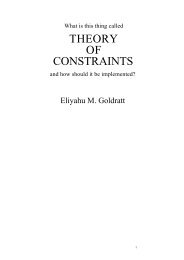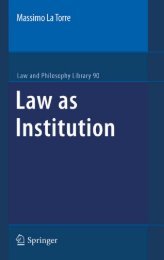Making of a German Constitution : a Slow Revolution
Making of a German Constitution : a Slow Revolution
Making of a German Constitution : a Slow Revolution
You also want an ePaper? Increase the reach of your titles
YUMPU automatically turns print PDFs into web optimized ePapers that Google loves.
Images <strong>of</strong> the Gemeinwesen • 115Europe: ‘It is not vaterländisch to us, was not produced and grown on our groundand stands, in its essence, in fundamental conflict to our way <strong>of</strong> thinking, and, for thatvery reason, can never satisfy us.’ 93 Rather, as he stated poignantly, the legal precedentsspoken ‘from the mouth <strong>of</strong> the country people (landvolks)’ formed a ‘highlypeculiar phenomenon in our ancient constitution, that is not found amongst any otherpeople and is a glorious witness to the free and noble nature <strong>of</strong> our native laws’. 94The north <strong>German</strong> constitutional politics <strong>of</strong> the Grimm brothers’ folklore researchand work on the Deutsches Wörterbuch was evident in Rechtsalterthümer. In thelengthy, 300-page Einleitung, Jacob developed what was essentially legal philology.The symbolism <strong>of</strong> common folk language was treated as an organic storehouse <strong>of</strong>the ancient constitution. This brand <strong>of</strong> legal philology was a central feature <strong>of</strong> Rechtsalterthümer,and it marked the beginning <strong>of</strong> a kind <strong>of</strong> hyper-politicization <strong>of</strong> everyordinary element <strong>of</strong> <strong>German</strong> culture. Arm und Hals ‘appeared as the symbols <strong>of</strong> subjection’,he argued, and ‘to lay ones throat or neck under an arm or to have an armlaid over ones throat’, implied that person was unfree and owned by another person. 95He also <strong>of</strong>fered a lengthy discussion on the legal symbolism <strong>of</strong> Hand und Finger,reasoning that ‘considered symbolically, the hand was like a scepter in the importance<strong>of</strong> power’. 96 Haar und Bart ‘were the symbols and dress <strong>of</strong> the emancipated, freeclass’. 97 Der Hut was a symbol <strong>of</strong> freedom and ‘for the delegation <strong>of</strong> goods and fee orfeudal tenure’. 98 Der Hammer, originally a weapon, became a symbol <strong>of</strong> court authority:‘A judge slammed down his hammer after the legal transaction <strong>of</strong> goods.’ 99It cannot be emphasized enough that liberal political goals were at the heart <strong>of</strong>burgeoning research on the history <strong>of</strong> <strong>German</strong> private law and what I have calledPrivatrechts-Staatslehre. The ultimate right that liberals claimed was bürgerlichesovereignty, at the heart <strong>of</strong> which was the right to make the laws. Conferring title<strong>of</strong> prescription on the people’s right to sovereignty was critical, and the research<strong>of</strong> legal antiquarians was designed to prove the pedigree <strong>of</strong> <strong>German</strong> liberties. Thisencouraged a belief in an ancient <strong>German</strong> constitution, which was nourished by themyth <strong>of</strong> original freedom. At the same time, this led to preoccupation with the originalsociopolitical constitution <strong>of</strong> all <strong>German</strong> relationships, and, increasingly, thispurported original character became the justification for constitutional form. On theone hand, there was original liberty, but, on the other, as was already evident inJacob’s philological treatment, there were also a host <strong>of</strong> original unfreedoms.By the 1820s, political writers were preoccupied with the law and increasinglyidentified with the Gemeinwesen (commonwealth) as the normative form <strong>of</strong> a freestate. According to Conversations-Lexikon (1820), ‘republic in the sense <strong>of</strong> ancienttimes’ referred to a ‘commonwealth <strong>of</strong> the citizens.’ 100 In his frequently cited DieStaatswissenschaft im Lichte unserer Zeit (1827), Karl Pölitz wrote: ‘The basic character<strong>of</strong> a republican form <strong>of</strong> government, in contrast to a monarchy, is that the ruler(Regent) in a republic is only the highest civil servant (Beamte) <strong>of</strong> the State.’ 101 Writtenfor scholarly and popular audiences, Johann von Aretin’s Staatsrecht der constitutionellenMonarchie: Ein Handbuch für Geschäftsmänner, studierende Jünglinge,




